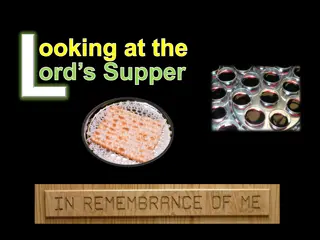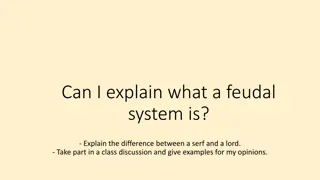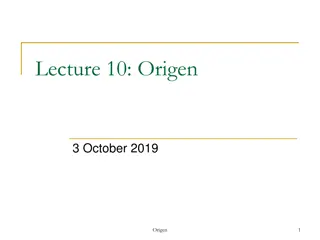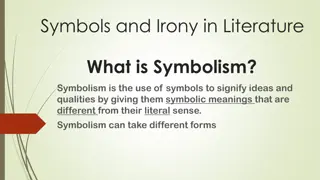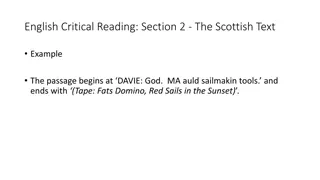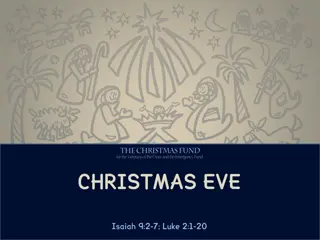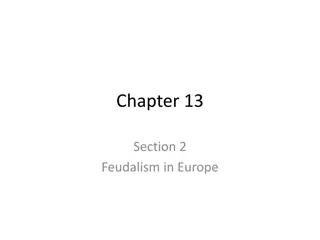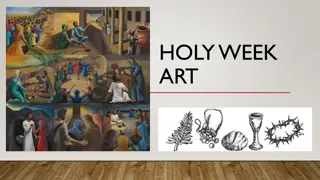Understanding the Lord's Supper and Its Symbolism in Scripture
Exploring the elements and context of the Lord's Supper based on Biblical passages such as 1 Corinthians 11:23-26, shedding light on the significance of the Passover, bread symbolism, the use of one loaf, and the meaning behind partaking in the one bread. The imagery of the cup and fruit of the vine is also elucidated, aligning Biblical references with historical context. The article delves into the theological significance of these elements and their representation in Christian communion practices.
Download Presentation

Please find below an Image/Link to download the presentation.
The content on the website is provided AS IS for your information and personal use only. It may not be sold, licensed, or shared on other websites without obtaining consent from the author. Download presentation by click this link. If you encounter any issues during the download, it is possible that the publisher has removed the file from their server.
E N D
Presentation Transcript
Elements of the Lord s Supper
Context of Establishment
Passover Luke 22:15 Mark 14:12 Nisan 14 Exod. 12:1-20
Non-Passover Theory John 18:28
Passover Terminology Luke 22:1 Lev. 23:8 Deut. 16:2
Unleavened Bread Exod. 12:15 Exod. 29:2, 23
One Loaf? 1 Cor. 10:16-17 Acts 4:4
Jesus took only one loaf, which represented His one body. The Greek word for bread in Matt 26:26 is artos and is singular in number, denoting a loaf. Hence, the use of a plurality of loaves would also be a violation of specific authority they would violate the one loaf Billy Dickinson Are Individual Cups an Aid? Old Paths Advocate 58.6 (June 1, 1986) 6.
Artos Bread John 6:31 (sing.) Only one loaf?
What Does 1 Corinthians 10:17 Mean?
Paul writing to Corinth from Ephesus says that we are all Christians in Ephesus and Christians in Corinth we are all partakers of that one bread, of that one loaf. W. Curtis Porter Porter-Waters Debate. (Murfreesboro, TN: DeHoff Publications, 1952) 70.
The Cup Matt. 26:27 26:29 = fruit of the vine Bab. Talmud, fruit of the vine = wine (Beracoth 35a). Bible wine = product of grape from grape juice to vinegar (Isa. 65:8; Num. 6:3)
Since fermentation was considered a type of leaven, and all leaven was to be removed from the house during Passover, the implication is this juice was unfermented. Kenneth Chumbley The Gospel of Matthew (Nashville: Selfpublished, 1999) 463.
Unleavened Wine? Jewish Karaites The Torah states that there are two kinds of leaven, e r and am . The definition of e r is a leavening or fermenting agent that is an inedible substance, such as yeast and sourdough, which induces fermentation. am comes from the Hebrew word meaning sour as is therefore any edible food that has gone through a souring process, in other words any food that has fermented. Rekhavi, Meir Yosef. The Biblical Passover Haggadha. (Jerusalem: World Karaite Movement, 2004) 8.
Non-Refrigeration Theory Boiling and Filtering My Test: http://www.ancientroadpublications.com/St udies/BiblicalStudies/ GrapeJuiceTest.html
Water and Wine Rabbinical Jews (Mish. Beracoth 7.5) 2-3 to 1 (Bab. Talmud, Shabbat 77a) Cup of wine mixed with water 150 AD Justin, First Apology 65.


